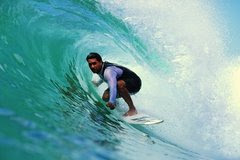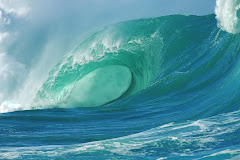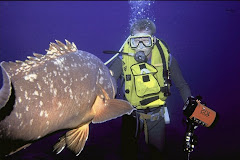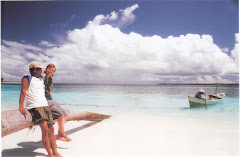
Ocean Ecotour Banyak Islands
The Banyak Island placed in Indonesian Ocean 25 miles from major city Singkil in Singkil Region of Nanggroe Aceh Darusalam Province. This Sumatran Bali Island consist of 99 islands.
With several choice from under water view in Tailana island, wave for surfing on june to july in Bangkaru island,under water park in Palambak island,perfect beach with beautifull white sand in Palambak island,animal conservation Bengkaru island,land tracking Haloban island and also awesome sunset and sun rise along the island, its one and only place in this planet you can find it all in one region.
Only with US$ 200/day/person for 6 - 8 person group booking you can travel all of the place including accomodation,transportation, food and beverage,local culture such as traditional dancing we will give you warm wellcome starting from Medan City in North Sumatra.
IN THE VILLAGES
 Weddings and circumcision-ceremonies are colorful and interesting to see. Traditional dances have their origin mainly in the Minangkabau culture (West Sumatra), but are specific for Pulau Banyak. A very special dance is "Lansir Madam", an odd remnant from the Dutch colonial times. In the village of Ujung Sialit traditions have their origin in Nias.
Weddings and circumcision-ceremonies are colorful and interesting to see. Traditional dances have their origin mainly in the Minangkabau culture (West Sumatra), but are specific for Pulau Banyak. A very special dance is "Lansir Madam", an odd remnant from the Dutch colonial times. In the village of Ujung Sialit traditions have their origin in Nias.
The languages spoken on the islands are Jamee (similar to Minangkabau), Haloban (the original language) and Nias.
Desa P. Balai and P. Baguk are both located on the relatively small island of Pulau Balai. They have since long grown together. It is the administrative and commercial center for Pulau Banyak and the main entry point for visitors. Almost 3.000 people live here. The local language is Jamee.
As these two villages were very heavily damaged by earthquake and tsunami in 2004 there is not much left of the former accommodations. The island sank more or less one meter. Most houses along the waterfront stand now in water. Until recently only one losmen were in operation, but one more have started and more is on its way.
 If you prefer village life, P. Balai and P. Baguk are rather nice. The accommodation is nice and food is good, especially the fish. It is close to several other nice islands and it is easy to charter a canoe or boat. Nice nearby islands are Pulau Baguk, Pulau Panjang, and Pulau Tapus-Tapus.
If you prefer village life, P. Balai and P. Baguk are rather nice. The accommodation is nice and food is good, especially the fish. It is close to several other nice islands and it is easy to charter a canoe or boat. Nice nearby islands are Pulau Baguk, Pulau Panjang, and Pulau Tapus-Tapus.
Desa Teluk Nibung is not far from P. Balai, just over the water on the island named Ujung Batu. More than 1.000 people live in this village. Teluk Nibung has a very beautiful Mosque in the old style. There are interesting rock formations on the northern end of this island. They are best seen from a boat. Otherwise there are mostly small orchards.
Desa Ujung Sialit with its app. 600 inhabitants is located on the northeastern point of Pulau Tuangku. The inhabitants are all of Nias descent and arrived in the first half of the last century. It has the only church in Pulau Banyak. They are Christians and speak Nias language. Nearby is the nice Pulau Pabisi.
Desa Suka Makmur is a new village with less than 500 inhabitants south of Ujung Nias. A boardwalk leads through the mangroves into the village.
 Desa Haloban and Desa Asantola was the administrative center of Pulau Banyak before the Japanese occupation. Now it will soon become the center for a new sub-regency when Pulau Banyak will be divided in two. More than 1.000 people live in these two villages grown together. They have their own language, Bahasa Haloban, which unfortunately is less and less used by the villagers.
Desa Haloban and Desa Asantola was the administrative center of Pulau Banyak before the Japanese occupation. Now it will soon become the center for a new sub-regency when Pulau Banyak will be divided in two. More than 1.000 people live in these two villages grown together. They have their own language, Bahasa Haloban, which unfortunately is less and less used by the villagers.
Haloban has no nice beaches by itself, but many of the best islands of Pulau Banyak are spread out in front of it. Behind is the untouched and unknown jungles of Pulau Tuangku. From here one can also climb the highest mountain in Pulau Banyak, Gunung Tiusa; 313m above sea level. Haloban is a good starting point for jungle trekking. See below.
Big parts of Haloban were destroyed by earthquake and tsunami. The houses near the waterfront get flooded at extreme tide.
ISLANDS WITH BUNGALOWS
 Pulau Palambak Besar is the forth biggest island in Pulau Banyak. It takes a few hours to walk around it. It has white sand beaches almost all around it. Palambak Besar is known for its perfect beaches. In the middle of the island is a swamp forest and a couple of small hills. There are a few huts where caretakers of the palm tree orchards live. The caretakers are very friendly and helpful.
Pulau Palambak Besar is the forth biggest island in Pulau Banyak. It takes a few hours to walk around it. It has white sand beaches almost all around it. Palambak Besar is known for its perfect beaches. In the middle of the island is a swamp forest and a couple of small hills. There are a few huts where caretakers of the palm tree orchards live. The caretakers are very friendly and helpful.
Palambak Besar was in the old days the most popular island amongst back packers. There were three small resorts, PAP, The Point and Bina Jaya. At the site of The Point the Regency government has built and rebuilt some bungalows, unfortunately not as nice as it once was. It has no name yet. Where PAP once were, a new place is now being built. It has the same owner and the name will be the same.
To the east is Pulau Palambak Kecil, nice for a day trip. Outside the northeastern point were nice sand banks before tsunami. Now they are growing back up again.
 There are a fair number of birds on Palambak: Great-billed Heron, Pacific Reef Egret, White-bellied Fish-eagle, Brahminy Kite, Common Ringed Plover, Pink-necked Green Pigeon and Pied Imperial Pigeon. Sometimes a Hawksbill turtle can be seen laying eggs.
There are a fair number of birds on Palambak: Great-billed Heron, Pacific Reef Egret, White-bellied Fish-eagle, Brahminy Kite, Common Ringed Plover, Pink-necked Green Pigeon and Pied Imperial Pigeon. Sometimes a Hawksbill turtle can be seen laying eggs.
Pulau Tailana is one of the more well known islands amongst visitors to Pulau Banyak. It was a popular daytrip island and have always had better snorkeling then most other islands. The island is relatively small, but has many other islands in its vicinity, for example Pulau Balong, Pulau Matahari and Pulau Ragu-Ragu. To the east of Pulau Tailana is an area where Dugongs often are sighted. Some bungalows are now being built here.
These two islands, Pulau Tailana and Pulau Palambak Besar have different characteristics and both are well worth a try. If you have time, try both.
OTHER CORAL ISLANDS
 There are too many islands to mention. Most of them are really nice and camping is ideal for the adventurous who doesn't want to share an island with other foreigners.
There are too many islands to mention. Most of them are really nice and camping is ideal for the adventurous who doesn't want to share an island with other foreigners.
Just going around in a boat is highly recommended. The scenery is fantastic and Turtles, and Mantarays are often sighted. The area between Sikandang and Tailana is also the home of the rare Dugong (a kind of Sea cow). A small motorized canoe can take up to four passengers. It is slow, but cheap. A big diesel powered fishing boat cost a bit more, but you can be more to share it. It is more comfortable, but cannot enter shallow areas and rivers. Speed boats are fast and convenient and allows you to see many places in one day. See under TRANSPORTATION.
 Islands worth mentioning are Balong, Tambarat, Biawak, Pabisi, Lambodong, Panjang, Ragu-Ragu, Sikandang, and Asok. The islands along the east coast of Tuangku are covered by mangroves and are mosquito ridden.
Islands worth mentioning are Balong, Tambarat, Biawak, Pabisi, Lambodong, Panjang, Ragu-Ragu, Sikandang, and Asok. The islands along the east coast of Tuangku are covered by mangroves and are mosquito ridden.
Beware that the sun can be very strong and the reflections from the sea makes it so much more powerful. Use good sun lotion or sun block. Don’t forget a hat or cap and sun glasses.
 For over night stays in the island you can either camp or just stay with the caretakers of the coconut orchards. They can also help you with cooking, if you bring the rice.
For over night stays in the island you can either camp or just stay with the caretakers of the coconut orchards. They can also help you with cooking, if you bring the rice.
Don't forget to give them some money for their help. That is customary and keep them happy when others come by. It is very primitive, but also very special and interesting. Fish is always easy to find; either buy from a fisherman or fish yourself.
To see the turtles on Pulau Bangkaru you need a special permit from YPB (Yayasan Pulau Banyak) the foundation that just have restarted turtle monitoring and conservation. Visits are only allowed at certain times. A volunteer program is also available. See under TURTLE CONSERVATION.
PULAU TUANGKU AND TREKKING
Pulau Tuangku is with its 11.500 hectares the biggest island of all. Most of this island is covered by virgin low land coastal jungle and not many people have seen the interior of this island. For an adventurous jungle lover this island offer unique possibilities. The wildlife is fairly rich considering the size of the island and its distance to the mainland. There are many kind of birds and snakes, even crocodiles, wild boars, monkeys, squirrels and mouse deer. There are probably endemic reptiles and maybe an endemic race of the Red-breasted Parakeet. The larger sub-specie of the Hill Myna, called Beo Nias, is common on Pulau Tuangku and Pulau Bangkaru.
 The east and west coast have mangrove forest. Before tsunami they were intact and extremely tall. Big areas died during tsunami, but it seems that they are coming back. There are several small rivers on the east and north coasts, big enough to enter with a canoe to see the flora and fauna.
The east and west coast have mangrove forest. Before tsunami they were intact and extremely tall. Big areas died during tsunami, but it seems that they are coming back. There are several small rivers on the east and north coasts, big enough to enter with a canoe to see the flora and fauna.
The west coast has several great jungle fringed beaches with big rolling waves. In the inland there are some hills and several caves. This gives the opportunity to combine jungle trekking in daytime and spending the nights on beaches.
South of Ujung Sialit is the stalagmite and stalactite cave named Tambego. It is a nice stop if you are passing by.
 In the southern end is Ujung Lolok. This southernmost point of Pulau Tuangku is actually on a different island, separated from Pulau Tuangku by a very narrow passage which looks like a river. The water is even brackish as there is a freshwater well in the passage. Because of this a special kind of edible shellfish is living here. The area has become popular for its surfing. (See below.)
In the southern end is Ujung Lolok. This southernmost point of Pulau Tuangku is actually on a different island, separated from Pulau Tuangku by a very narrow passage which looks like a river. The water is even brackish as there is a freshwater well in the passage. Because of this a special kind of edible shellfish is living here. The area has become popular for its surfing. (See below.)
Haloban is the most suitable starting point for treks into the jungle. The jungle is in very good condition and one can end every day of trekking at a beach. The few reports are lyrical. A walk along the north coast to the west and down south along the beaches can be also recommended. A nice day trek is up to the summit of Gunung Tiusa, 313m above sea level. Enjoy a great view over the archipelago. One possible route is to walk from Haloban to Teluk Dalam were the original Haloban once were located. Walk further and up the Asantola River as far as possible. Continue over the land to the west to the beautiful beach Pasir Panjang. There is a bat cave behind the beach. Walk along the beach to Teluk Limo where it is possible for a boat to pick you up.
SURFING
Surfing is a new activity that has developed in Pulau Banyak, promoted by operators in North and West Sumatra. Most surfers visit the Pulau Banyak waters without even setting a foot on dry land. Unfortunately the local community is not yet involved. An alternative for surfers is to charter a local boat in P. Balai and arrange the surfing themselves. That would probably be cheaper, more adventurous, transfer needed know-how to the local community, help the local economy, and to increase awareness about sustainable tourism.
The two major areas where surfer boats visit are the southern points of Pulau Tuangku and Pulau Bangkaru, Ujung Lolok and Ujung Lakita respectively. Pulau Tuangku is by the surf operators called the Treasure Island and Pulau Bangkaru is called the Turtle Island.
Article by www.sumatraecotourism.com
How to Travel
acehsingkil.paradise@gmail.com
Or contact person Febri +6281260468130 and Firaza at
+6281264080704
PALAMBAK HOLIDAYS
Jl. Bahari Pulau Sarok
Singkil - Nanggroe Aceh Darusalam
Indonesia
Ph : 62658 21229
Speed Boat
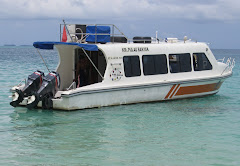
Transportation around the islands













